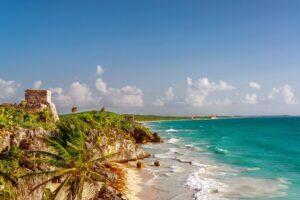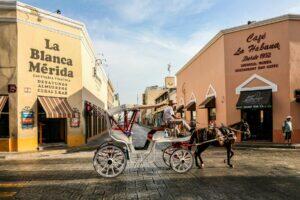Fodor's Expert Review Edzná
A major metropolis in its day, Edzná was situated at a crossroads between cities in modern-day Guatemala and the states of Chiapas and Yucatán, hence it features a mélange of Maya architectural elements. Roof combs and corbeled arches evoke those at Yaxchilán and Palenque, in Chiapas, and giant stone masks resemble the Petén-style architecture of southern Campeche and northern Guatemala.
Edzná began as a humble agricultural settlement around 300 BC, reaching its pinnacle in the Late-Classic period, between AD 600 and 900, then gradually waning in importance until being all but abandoned in the early 15th century. Today, soft breezes blow through groves of slender trees where brilliant orange and black birds spring from branch to branch. Clouds scuttle across a blue backdrop, perfectly framing the mossy remains of once-great structures.
One highlight is the five-story Pirámide de los Cinco Pisos, which was built on the raised platform of the Gran Acrópolis (Great... READ MORE
A major metropolis in its day, Edzná was situated at a crossroads between cities in modern-day Guatemala and the states of Chiapas and Yucatán, hence it features a mélange of Maya architectural elements. Roof combs and corbeled arches evoke those at Yaxchilán and Palenque, in Chiapas, and giant stone masks resemble the Petén-style architecture of southern Campeche and northern Guatemala.
Edzná began as a humble agricultural settlement around 300 BC, reaching its pinnacle in the Late-Classic period, between AD 600 and 900, then gradually waning in importance until being all but abandoned in the early 15th century. Today, soft breezes blow through groves of slender trees where brilliant orange and black birds spring from branch to branch. Clouds scuttle across a blue backdrop, perfectly framing the mossy remains of once-great structures.
One highlight is the five-story Pirámide de los Cinco Pisos, which was built on the raised platform of the Gran Acrópolis (Great Acropolis). Hieroglyphs carved into the vertical faces of the 15 steps between each level (some re-cemented in place by archaeologists, although not necessarily in the correct order), as well as into stelae throughout the site, depict the opulent attire once worn by the Maya ruling class—quetzal feathers, jade pectorals, and jaguar-skin skirts. On the pyramid's top level sit the ruins of three temples and a ritual steam bath.
The Pirámide de los Cinco Pisos was constructed so that on certain dates the setting sun would illuminate the mask of the creator-god, Itzamná, inside one of the pyramid's rooms. This still happens on May 1, 2, and 3, the beginning of the Maya planting season, and on August 7, 8, and 9, the days of harvesting and giving thanks.
West of the Great Acropolis, the Puuc-style Plataforma de los Cuchillos (Platform of the Knives) was so named by the archaeological team that found a number of flint knives inside. To the south, four buildings surround a smaller structure called the Pequeña Acrópolis (Small Acropolis). Twin sun-god masks with huge protruding eyes, sharp teeth, and oversize tongues flank the Templo de los Mascarones (Temple of the Masks, or Building 414), adjacent to the acropolis. The mask at the bottom left (east) represents the rising sun; the mask to the right represents the setting sun.
If you're not driving, consider taking one of the inexpensive day trips offered by tour operators in Campeche. Convenience aside, a guide can point out features often missed by the untrained eye, such as the remains of arrow-straight sacbés. These raised roads in their day connected one important ceremonial building within the city to the next, and also linked Edzná to trading partners throughout the peninsula.
READ LESS





